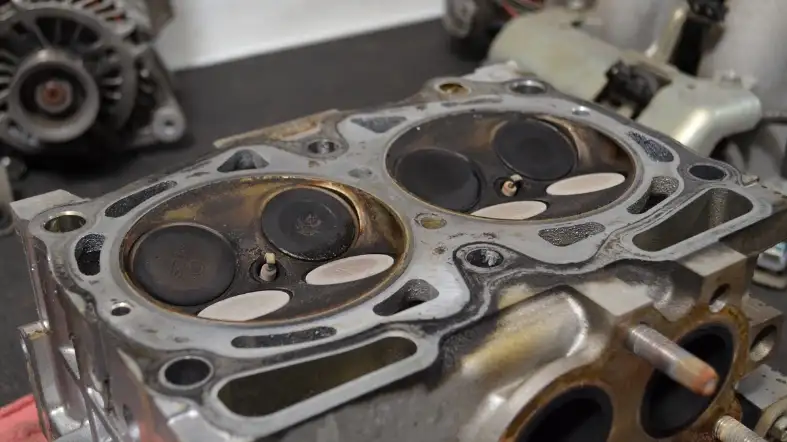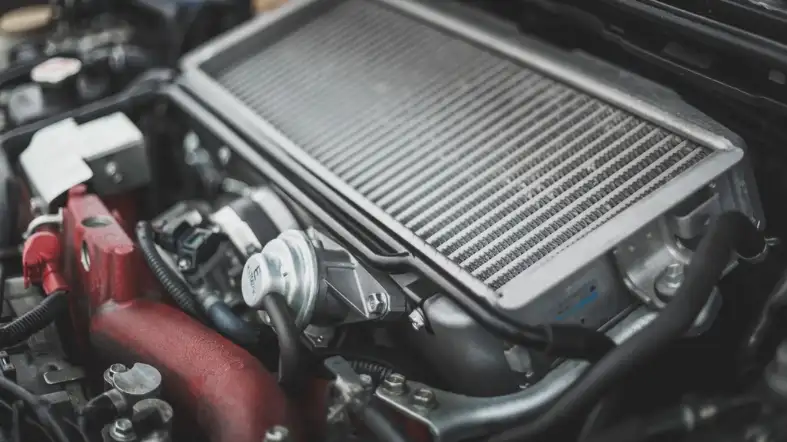Subaru is a popular car brand known for its reliability and durability. However, one issue that has plagued Subaru owners for years is head gasket failure.
If you own a Subaru, you may have heard horror stories about head gasket problems and the costly repairs that come with them. But why do Subaru head gaskets fail in the first place?
Today we will take a closer look at this issue and explore some factors contributing to head gasket failure in Subaru vehicles.
Why Do Subaru Head Gaskets Fail?
There are a few reasons why Subaru head gaskets are notorious for failing.

Material:
The most common cause of Subaru head gasket failure is that the gaskets were made using a multilayer steel (MLS) design that was not up to par.
This design cannot deal with the stresses of the engine.
Manufacturing Defects:
Poor manufacturing of the head gaskets can also be a culprit. The coolant and oil can leak around the seal if the gaskets aren’t perfectly flat.
Overheating:
Overheating a Subaru engine can cause the head gasket to fail as the metal expands and contracts causing the gasket to blow out completely.
Age and Mileage:
The head gaskets on Subaru engines tend to start failing around 100,000 miles, depending on how they have been driven and maintained.
Also, wear and tear can weaken and deteriorate the gasket over time.
Signs Of A Blown Subaru Head Gasket
Here are the signs of a blown Subaru head gasket:
Overheated Engine
One of the most common signs of a blown Subaru head gasket is an overheated engine.
If the head gasket fails, hot gases from the exhaust can enter the cooling system, or coolant can leak into the cylinders, causing the engine to overheat.
Overheating can lead to further damage to the engine, so it’s essential to address the problem immediately.
Loss of Power and Rough Engine
When a head gasket fails, it can allow compressed air and fuel to escape, reducing that cylinder’s compression.
This loss of compression can cause the engine to run roughly, resulting in a notable reduction in engine power.
A sound like an exhaust leak typically accompanies this failure.
External Leaks
An external oil or coolant leak at the seam between the engine block and cylinder head indicates that the head gasket has failed or the block has cracked.
This leak can be seen as stains on the bottom of the head near the gasket joint. It’s essential to check for these leaks and address them promptly.
Cylinder Misfire
A cylinder misfire is another sign of a blown Subaru head gasket. If the head gasket fails, it can allow coolant to enter the combustion chamber, resulting in a misfire.
Exhaust Smoke
Exhaust smoke is a sign of a blown head gasket. If the head gasket fails, coolant can enter the combustion chamber, resulting in white smoke from the tailpipe.
Blue or black smoke may also indicate a head gasket failure.
Engine Oil Contamination
If the head gasket fails, coolant can enter the engine oil passages, contaminating the engine oil. The oil will appear milky and frothy in this case.
Bubbling in Radiator
A blown head gasket can cause bubbling in the radiator. If the head gasket fails, exhaust gases can enter the coolant passages, resulting in bubbles in the radiator.
The Most Affected Subaru Years And Models

The following models and years have been affected by these problems:
Subaru Outback:
According to industry reviews and NHTSA statistics, the worst model years for the Outback are 2020, 2019, 2018, 2017, 2011, 2006, and 2005, while the best model years are 2022, 2021, 2014, 2013, 2012, 2009, 2008, 2007, 2004, and 2003.
Subaru Forester:
The most affected Forester models are the 2011-2014 models with the 2.5-liter engine.
Furthermore, people who own Subaru from 2011 to 2015 Outback, Forester, Legacy, Impreza, and Crosstrek, report an oil consumption problem that has cost them hundreds or even thousands of dollars for repairs.
Subaru Impreza:
Head gasket problems seem to affect Impreza models from 1999 to 2011.
Additionally, the models affected by an engine sensor malfunction in 2022 were Imprezas, with model years 2017, 2018, and 2019.
Subaru Legacy:
Head gasket problems affect Legacy models from 2000 to 2009.
Subaru Crosstrek:
The models affected by an engine sensor malfunction in 2022 were Crosstreks with model years 2018 and 2019.
Factors That Contribute To Subaru Head Gasket Failures
Various factors can contribute to this problem, including:
Model Years and Engine Types
The main problem years for Subaru head gasket failures are 1996 through 2004.
The most commonly affected engine is the naturally aspirated (non-turbo) Subaru 2.5 L four-cylinder engine, also known as the EJ25 motor. ‘
The single overhead camshaft (SOHC) variant experiences failures much more frequently than the dual overhead camshaft (DOHC) version.
It is worth noting that the external head gasket leaks tend to occur in phase 2 engines EJ251, etc., from 1999 to 2004, and to a lesser degree in later models.
Design and Material of Head Gaskets
Subaru’s decision to use a composite-style head gasket in some models from 1997 to 1999 contributes to head gasket failures.
This gasket featured a multi-layer steel shim coated with a graphite layer, which allowed coolant leaks into the exhaust pressure and combustion chamber.
Furthermore, the graphite-coated gaskets have been identified as problematic and the cause of head gasket failures.
Overheating Engines and Abnormal Combustion
An overheating engine is one of the most common reasons for head gasket failure in a Subaru.
When the head gasket isn’t sealed as it should be, hot gases from the exhaust end up in the cooling system, or the coolant can leak into the cylinders, leading to more problems.
Abnormal combustion, such as detonation or pre-ignition, can also lead to head gasket failure in Subaru engines, particularly in the turbocharged models with increased cylinder pressures.
Poor Maintenance
Poor maintenance is also a contributing factor to Subaru head gasket failures.
For instance, failure to replace the coolant in the engine can lead to corrosion of the head gasket, eventually causing it to fail.
Preventive Maintenance Tips To Reduce Subaru Head Gasket Failures

Here are some preventive maintenance tips to reduce the likelihood of Subaru head gasket failures:
Check the coolant levels:
Regularly check them to ensure they are at the appropriate levels. Low coolant levels can cause the engine to overheat, which can lead to head gasket failures.
If you notice that the coolant levels are consistently low, you must check for leaks or other issues that may be causing the problem.
Check for leaks:
Inspect your Subaru regularly for any signs of coolant or oil leaks, which can indicate a head gasket failure.
Look for stains on the engine block, cylinder head, or the ground where you park your car. Address any leaks immediately to avoid further damage to the head gasket.
Perform regular oil changes:
Regular oil changes are essential to keep your engine running smoothly and reduce the risk of head gasket failures.
Old, dirty oil can cause engine overheating and strain the head gasket unnecessarily.
Avoid engine overheating:
Overheating is one of the most common causes of head gasket failures.
To avoid this, keep an eye on the engine temperature gauge and avoid driving in extreme heat or stop-and-go traffic.
Ensure that the radiator and cooling system is functioning correctly and free from blockages.
Address engine misfires immediately:
A misfiring engine can cause hot exhaust gases to escape through the head gasket, leading to head gasket failure.
If you notice a rough-running engine or a loss of power, address the issue immediately to avoid further damage.
Consider replacing the head gasket:
If your Subaru has high mileage, you may want to consider replacing the head gasket as a preventative measure.
A new head gasket can help prevent leaks and reduce the risk of head gasket failure in the future.
Subaru’s Response To The Head Gasket Problem
Subaru has acknowledged and addressed the head gasket problem that has affected several of their car models over the years.
While there was no official recall for the issue, the company extended the warranty period for specific models to address the problem.
Subaru addressed the head gasket issue by changing the design of the gaskets used in their newer models.
The company has also been using better materials for their head gaskets in more recent models to prevent the issue from occurring.
Subaru has been known to cover the cost of head gasket replacement for certain models under their warranty program.
The warranty covers head gasket replacements for a period of up to 100,000 miles, depending on the specific model and year.
Overall, Subaru has taken steps to address the head gasket problem, including improving the design and materials of their gaskets and offering warranties to cover the cost of replacement for specific models.
Frequently Asked Questions
Are Some Subaru Models More Prone To Head Gasket Failure Than Others?
Yes, specific Subaru models are more prone to head gasket failure than others.
The 2.5-liter EJ25 engine, which is found in models such as the Forester, Impreza, Outback, Legacy, and Baja, is particularly susceptible to head gasket problems.
Additionally, this engine’s naturally aspirated (non-turbo) version is more likely to experience head gasket failure than the dual overhead camshaft (DOHC) variant.
Can Head Gasket Failure Be Prevented In Subarus?
While head gasket failure cannot always be prevented in Subarus, there are steps you can take to reduce the risk.
These include maintaining your engine’s cooling system by flushing and replacing the coolant at the recommended intervals, monitoring your engine’s temperature gauge, and addressing any overheating issues promptly.
Also, choosing a reputable mechanic familiar with Subaru engines can help ensure your vehicle is properly maintained.
What Is Subaru’s Response To The Head Gasket Problem?
Subaru has not issued a recall specifically related to head gasket problems in their vehicles.
However, they have extended their powertrain warranty to eight years or 100,000 miles for specific models that are known to be susceptible to head gasket failure.
Additionally, Subaru has updated the head gasket design for some of its engines to improve reliability.
Can A Blown Head Gasket Cause Other Engine Problems?
Yes, a blown head gasket can cause other engine problems if left unaddressed.
For example, coolant leaking into the combustion chamber can cause cylinder misfires and damage to the catalytic converter.
Additionally, overheating can cause damage to other engine components, such as the water pump and the thermostat.
Conclusion:
Subaru head gasket failure is a frustrating and costly problem that many Subaru owners have experienced.
While several factors contribute to this issue, the most common cause is overheating.
By staying informed and taking proactive measures, you can minimize the risk of head gasket problems and enjoy your Subaru for many years to come.
